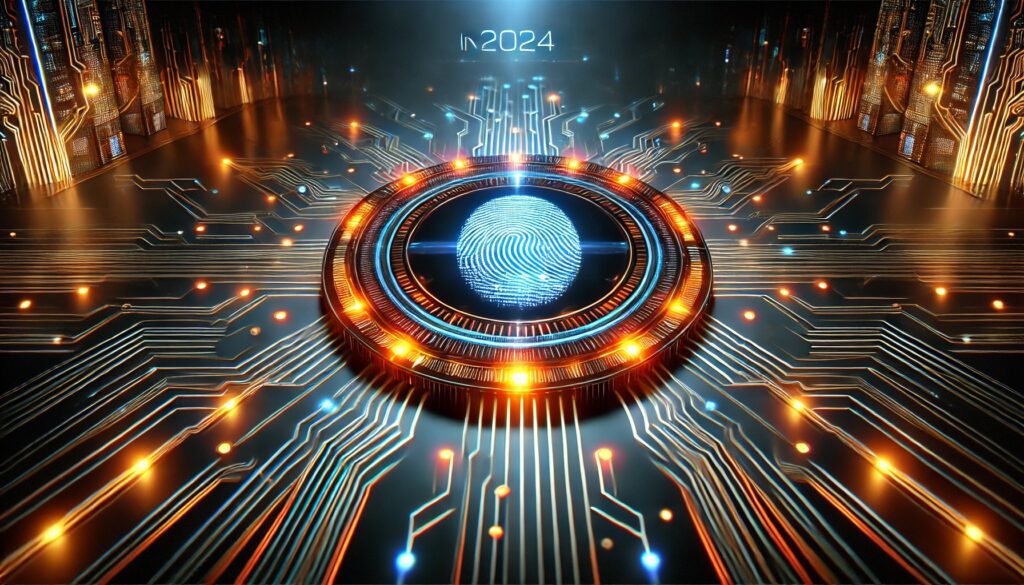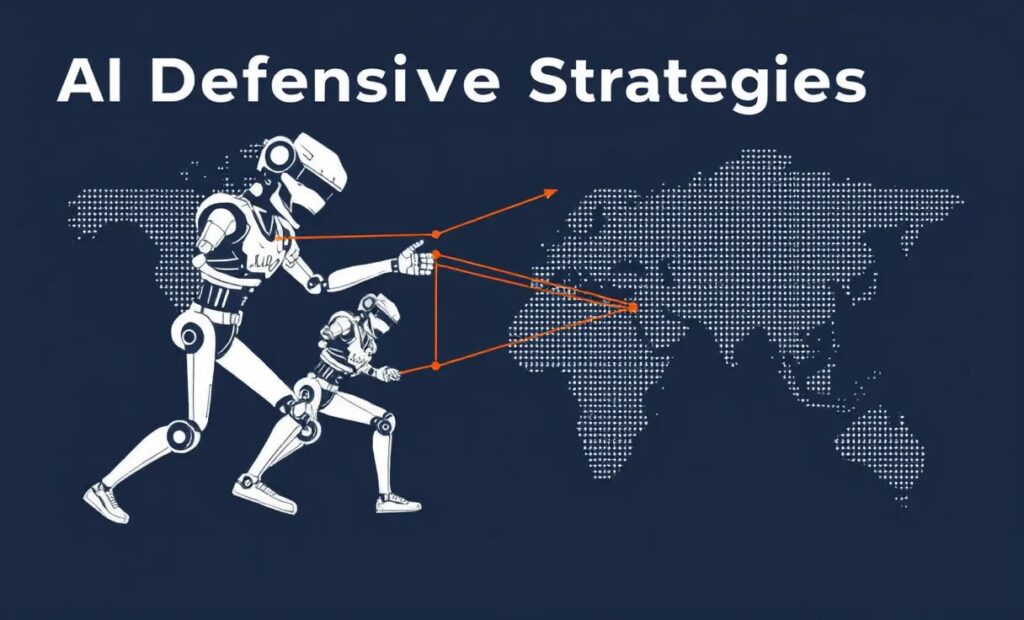
“Rapid increase in hacker attacks – the UK is on the brink of a cyber catastrophe.” Headlines like this illustrate a dilemma. Defenders bolster their systems with AI, attackers are also weaponizing the technology.
This creates an intriguing dynamic: AI battling AI. Who will win?
How Cybercriminals Use AI for Attacks
AI-Powered Phishing Tactics
AI allows hackers to automate and refine phishing attacks. Machine learning models analyze user data, creating convincing, personalized bait. These attacks are harder to detect because they mimic legitimate communication styles almost perfectly.
For instance, AI can generate fake emails with subject lines tailored to each target. According to research by Proofpoint, these spear-phishing attacks have a success rate far higher than generic spam. Cybersecurity defenses need to evolve fast to counter this trend.
Deepfake Technology and Fraud
Deepfakes—AI-generated fake videos and audio—pose a massive threat. Hackers use them to impersonate CEOs or high-ranking officials, convincing employees to transfer funds or reveal sensitive data. This new breed of attack is incredibly persuasive and often goes unnoticed until it’s too late.
Autonomous Malware
AI can create adaptive malware capable of learning and evolving. Unlike traditional threats, these intelligent programs adjust their tactics based on the system they attack, bypassing security measures with ease.
AI-driven malware analysis tools like Cylance have become essential in detecting such threats. But as malware grows smarter, so must the defenses.
AI as the Defender: The Cybersecurity Vanguard
Real-Time Threat Detection
Modern cybersecurity tools use AI to detect and neutralize threats in real time. For example, systems like CrowdStrike identify unusual patterns in network traffic, flagging potential breaches before they occur. These tools act faster and with more precision than traditional security measures.
Behavioral Analytics
AI analyzes user behavior to spot anomalies that indicate a threat. If someone logs into your account from two different countries within minutes, AI can block the activity. This approach minimizes false positives while improving security accuracy.
Automated Patch Management
AI also helps close security gaps by automating software updates. This proactive approach ensures that vulnerabilities are addressed before hackers exploit them.

The Role of Machine Learning in This Arms Race
Training AI for Defense
Defensive systems use machine learning models trained on large datasets of previous attacks. These models improve over time, learning to spot even the subtlest signs of an intrusion.
Attack Simulations
AI-powered systems run continuous simulations, testing networks for vulnerabilities. These “white hat” AI attackers mimic real cyber threats, preparing defenses for future challenges.
This constant feedback loop ensures that cybersecurity systems stay one step ahead—or at least try to.
Ethical Dilemmas in AI-Driven Cybersecurity
Weaponization of AI: Where’s the Line?
As AI becomes more advanced, its potential for misuse grows. The same tools that protect systems can be repurposed to breach them. This dual-use nature poses ethical questions: Should organizations develop technologies that could be weaponized?
Many governments are pushing for regulation, but cybercriminals don’t play by the rules. Without a global consensus, the ethical debate continues while the battlefield expands.
Bias in AI Algorithms
AI is only as good as the data it’s trained on. If the data contains biases, the system could misidentify threats or disproportionately flag specific users. This can lead to unfair outcomes, particularly for marginalized groups.
Efforts like the EU’s AI Act aim to address these issues, pushing for transparency in AI decision-making processes. But the challenge remains: How do we ensure fairness without compromising security?
Privacy Concerns
AI often requires vast amounts of data to function effectively. This raises concerns about how that data is collected, stored, and used. Striking a balance between privacy and security is crucial but challenging, especially as data breaches become more common.

Emerging AI Threats on the Horizon
AI-Human Collaboration in Cybercrime
Attackers are increasingly blending AI with human ingenuity. For example, humans craft the strategy, while AI automates execution. This hybrid approach results in more sophisticated and harder-to-detect attacks.
An example is the use of chatbots to socially engineer victims, tricking them into revealing credentials or clicking malicious links. The human-like behavior of these bots makes them highly effective.
AI-Powered Zero-Day Exploits
Zero-day exploits—attacks on undiscovered vulnerabilities—are already a major concern. AI accelerates their discovery, making it easier for cybercriminals to exploit weaknesses before they’re patched.
Traditional cybersecurity measures struggle to keep up, highlighting the need for real-time threat intelligence systems powered by machine learning.
Rogue AI Agents
As AI becomes autonomous, there’s a growing risk of rogue agents acting without human oversight. These agents could create or distribute malware, launching attacks without any direct command from hackers. Stopping such agents requires an entirely new approach to cybersecurity.
How Businesses Can Prepare for the AI Battle
Investing in AI-Driven Defenses
Companies must prioritize AI-powered cybersecurity solutions. Tools like FireEye and Darktrace use advanced algorithms to detect threats at unprecedented speed and accuracy. These investments are no longer optional—they’re essential.
Employee Training Programs
Technology alone isn’t enough. Educating employees on recognizing AI-enhanced threats, such as phishing emails or suspicious links, is equally critical. Regular training reduces the human error that often enables cyberattacks.
Incident Response Plans
AI can help mitigate attacks, but no system is foolproof. A robust incident response plan ensures that businesses can recover quickly when breaches occur. Regularly testing these plans keeps organizations prepared for worst-case scenarios.

The Future of AI in Cybersecurity
Collaboration Between Nations
Cybersecurity is no longer a local issue. Countries must collaborate to develop global standards and share intelligence. Initiatives like INTERPOL’s Global Cybercrime Strategy are steps in the right direction, but more action is needed.
Advances in Quantum AI
Quantum computing, combined with AI, promises to revolutionize cybersecurity. It could make encryption unbreakable—or render current methods obsolete. The race to leverage this technology will define the next decade of cybersecurity.
AI vs. AI Arms Control
As the battle intensifies, there’s growing discussion around creating AI-specific arms control agreements. These would regulate the development and deployment of offensive AI technologies, aiming to reduce the risks of escalation.
AI-Powered Threats: Unpacking the Tactics
Generative AI in Cybercrime
Generative AI, like large language models, has given hackers new tools to create convincing and scalable attacks. These systems can write fake but believable emails, generate fraudulent documents, or even produce malicious code. The level of sophistication makes it nearly impossible for traditional filters to flag them.
For example, GPT-like models can help cybercriminals craft phishing messages that bypass spam filters, perfectly mimicking an organization’s tone and style. Combined with stolen personal data, this makes their attacks almost indistinguishable from genuine communications.
AI in Reconnaissance
Before launching an attack, adversaries need intelligence. AI accelerates this process by analyzing massive datasets quickly. Tools used by attackers scan social media, public records, and leaked data to build a profile of their target. This precision allows for highly personalized attacks, increasing success rates.
Polymorphic Malware
Traditional malware follows a predictable pattern, but polymorphic malware evolves continuously. AI enables malware to rewrite its own code, creating a unique signature each time it spreads. This evasion technique makes detection nearly impossible for conventional antivirus programs.
AI-empowered security teams now rely on behavior-based detection, focusing on actions rather than signatures. Still, this method struggles against malware that mimics legitimate processes.
AI as a Shield: Advanced Defensive Strategies

Neural Networks for Threat Prediction
Neural networks excel at recognizing patterns and anomalies in data. In cybersecurity, they help identify potential attacks before they occur. By analyzing historical attack data, these systems predict what hackers might target next and adapt defenses accordingly.
For instance, systems like IBM Watson for Cyber Security analyze billions of data points, pinpointing vulnerabilities with uncanny accuracy. They can even prioritize which threats are most urgent.
Natural Language Processing (NLP) for Phishing Detection
NLP algorithms can analyze emails and text messages, identifying language patterns indicative of phishing attempts. These systems flag suspicious content even when attackers use AI-generated text, which traditional filters often miss.
Google’s Safe Browsing initiative integrates such technologies, warning users before they click on dangerous links. But as phishing emails evolve, maintaining this edge requires constant innovation.
Federated Learning in Security Networks
Federated learning enables AI systems to share knowledge across devices without exposing sensitive data. In cybersecurity, this means multiple systems can learn from each other’s experiences, strengthening defenses while preserving user privacy.
For example, if one device encounters a novel malware strain, the system informs others in the network. This collective intelligence significantly reduces response times.
AI Arms Race: The Ethical and Operational Implications
Defending Against AI in Disguise
One ethical dilemma is recognizing when AI systems unintentionally aid attackers. For example, publicly available AI models could be reverse-engineered for malicious purposes. Should organizations restrict access to these tools? Or does this stifle innovation?
Balancing accessibility with security is a pressing challenge. OpenAI and similar organizations now monitor API usage to prevent abuse, but this is far from a perfect solution.
AI’s Role in Cyber Deterrence
Some governments are exploring AI deterrence strategies, using defensive AI to dissuade attackers. By demonstrating advanced capabilities, they aim to make attacks too risky or costly for adversaries. However, this raises the risk of escalation, as attackers may respond by developing even more sophisticated tools.
Human Oversight in Automated Systems
While AI can automate many tasks, human oversight remains essential. Fully autonomous systems risk misidentifying threats or making decisions that escalate conflicts. Striking the right balance between automation and human control is a priority for ethical AI deployment.
Preparing for the Future: Practical Steps for Organizations
Developing AI Literacy in the Workforce
AI-driven threats require a workforce capable of understanding and responding to them. Organizations must train employees to recognize AI-enhanced attacks, such as spear-phishing emails and fake audio messages.
Gamified simulations, like phishing attack drills, help teams practice in realistic scenarios. This hands-on approach ensures employees are prepared for evolving threats.
Collaborating Across Industries
No organization can tackle AI cyber threats alone. Cross-industry collaborations allow businesses to share threat intelligence and defensive strategies. Platforms like the Cyber Threat Alliance (CTA) facilitate this exchange, strengthening collective resilience.
Investing in Ethical AI Research
Organizations must support research into explainable AI (XAI)—tools that provide transparency in decision-making processes. Understanding how AI systems detect threats improves trust and ensures they’re used responsibly.
The rise of AI has fundamentally changed the cybersecurity landscape. While it offers powerful tools for defense, the same capabilities enable devastating attacks. Navigating this battlefield requires constant vigilance, innovation, and a commitment to ethical practices. The stakes have never been higher—because in the AI vs. AI war, the ultimate target is us.
FAQs
What are the risks of using AI in cybersecurity?
The main risks include bias in algorithms, over-reliance on automation, and the potential for adversaries to exploit AI tools. For instance, attackers can train AI models on stolen data to craft more convincing phishing attacks or bypass standard security measures.
Another concern is false positives. If AI wrongly flags critical operations as threats, it could disrupt workflows or erode trust in the system. Regular audits and human oversight mitigate these risks.
How can businesses defend against AI-powered threats?
Businesses can use AI-enhanced tools to stay ahead of attackers. Key strategies include implementing behavioral analytics to detect anomalies, deploying real-time threat intelligence platforms, and conducting regular vulnerability assessments.
For example, a company could use Splunk to monitor network activity, flagging suspicious patterns like multiple failed login attempts from unknown locations. Regular employee training also helps reduce the risk of human error, a common entry point for attacks.
How does AI handle zero-day threats?
Zero-day threats exploit vulnerabilities that haven’t been discovered or patched. AI mitigates these by using predictive analysis and behavioral detection. Instead of relying on known signatures, AI identifies suspicious activities or patterns, even from entirely new malware.
For instance, tools like Palo Alto Networks’ Cortex XDR monitor how applications interact with systems. If a program behaves unusually—like accessing sensitive files without user permission—it can block the action immediately.
What are the limitations of AI in cybersecurity?
AI is powerful but not infallible. Its main limitations include:
- Dependence on data quality: Poor or biased datasets lead to flawed results. For example, an AI trained on incomplete attack scenarios might miss sophisticated threats.
- False positives: AI can overreact, flagging benign actions as malicious, causing unnecessary disruptions.
- High cost: Advanced AI systems often require significant investment, making them inaccessible to smaller organizations.
AI complements human expertise but doesn’t replace the need for skilled cybersecurity professionals.
How do AI-driven defenses handle ransomware attacks?
AI detects ransomware by analyzing file behavior and network activity. Ransomware often encrypts files rapidly or communicates with external servers for instructions. AI tools monitor for these anomalies, stopping attacks before significant damage occurs.
For example, Sophos Intercept X uses AI to block ransomware in real time. In one case, it identified and quarantined malicious software that had infiltrated a hospital’s network, preventing sensitive patient data from being encrypted.
What is adversarial AI, and why is it a concern?
Adversarial AI involves manipulating AI systems to make them fail or misbehave. Attackers feed malicious inputs, tricking AI models into ignoring threats or making wrong decisions. For instance, adding subtle alterations to an image might cause AI to misclassify it, a technique often used to bypass image-recognition systems.
In cybersecurity, adversarial AI might trick defenses into ignoring malware by masking its characteristics. To combat this, researchers are developing robust AI models resistant to such manipulation.
What industries are most at risk from AI cyberattacks?
Industries with high-value data or critical operations are prime targets. These include:
- Finance: AI is used to target financial systems, mimicking transactions or creating fake customer profiles.
- Healthcare: Patient data and critical medical systems are vulnerable to ransomware and deepfake scams.
- Manufacturing: Smart factories relying on IoT and AI systems face risks of sabotage through AI-manipulated malware.
For example, in 2021, hackers targeted a water treatment plant, attempting to alter chemical levels remotely. AI-driven monitoring systems were key in detecting and neutralizing the threat.
Can AI help prevent insider threats?
Yes, AI is highly effective at identifying insider threats, which often bypass traditional security measures. It uses behavioral analytics to monitor employee activities and flag unusual actions, like accessing sensitive files during non-work hours or transferring large amounts of data.
For example, AI might detect an employee copying sensitive data onto a USB drive after their resignation notice. Systems like ObserveIT help organizations catch such activities in real time, mitigating risks before data leaks occur.
How does AI integrate with IoT cybersecurity?
The Internet of Things (IoT) presents unique challenges, as connected devices often lack robust security. AI strengthens IoT defenses by monitoring device behavior and identifying abnormal activities, like unauthorized communication between devices.
Consider a smart thermostat that suddenly begins transmitting data to an unfamiliar server. AI-powered platforms like Zscaler IoT Security detect and block this activity, preventing potential breaches.
In smart cities, where IoT devices control critical infrastructure, AI ensures that systems remain secure against sophisticated attacks.
What are digital twins, and how do they enhance AI in cybersecurity?
Digital twins are virtual replicas of physical systems or networks. They enable organizations to test AI-driven defenses in a controlled environment, simulating attacks without risking real-world damage.
For example, a company might use a digital twin of its IT infrastructure to see how AI would respond to a ransomware attack. This proactive approach helps fine-tune defenses and identify vulnerabilities before attackers exploit them.
What is the impact of quantum computing on AI cybersecurity?
Quantum computing poses both opportunities and risks for AI-driven cybersecurity. On one hand, quantum computers can crack traditional encryption methods, rendering many current security measures obsolete. On the other hand, they enable the development of quantum-resistant algorithms and faster AI models for threat detection.
For instance, organizations are already exploring quantum-safe cryptography to prepare for the eventual rise of quantum-powered cyberattacks. AI will play a critical role in transitioning to these next-generation security protocols.
Resources
Organizations and Communities
- Cyber Threat Alliance (CTA)
An industry group where members share threat intelligence and collaborate on AI-enhanced cybersecurity strategies.
Visit their website - SANS Institute
Provides training, certifications, and resources on AI and cybersecurity for professionals.
SANS AI Cybersecurity Resources - AI4Cyber
A community focused on advancing AI technologies in cybersecurity.
Explore AI4Cyber
Research Papers and Journals
- “The Malicious Use of Artificial Intelligence: Forecasting, Prevention, and Mitigation”
A seminal paper detailing the dual-use nature of AI in cybercrime and defense.
Read it here - “Deep Learning for Cybersecurity”
Published in the IEEE Journal, this paper explores how neural networks are applied to threat detection.
IEEE Cybersecurity Journals - “Adversarial AI in Cybersecurity”
A detailed examination of how attackers exploit AI systems and how defenders can counter these techniques.
Tools and Platforms
- Darktrace
An AI-driven cybersecurity platform for detecting and responding to threats in real time.
Learn more about Darktrace - Cylance
Uses AI to prevent malware attacks before they execute, focusing on predictive analytics.
Cylance Official Site - Splunk
Offers AI-powered security information and event management (SIEM) tools for large-scale data monitoring.
Explore Splunk
Podcasts and Webinars
- “Smashing Security”
A lighthearted podcast covering the latest in cybersecurity, including discussions on AI threats and solutions.
Listen to Smashing Security - “CyberWire Daily Podcast”
Features expert insights on AI’s role in cybersecurity, highlighting emerging trends and news.
Visit CyberWire - AI-CyberSec Webinar Series by RSA Conference
Regular sessions discussing the latest developments in AI for cybersecurity.
RSA Conference Webinars
News and Updates
- The Hacker News
Stay updated on the latest cyber threats and how AI is evolving to combat them.
Visit The Hacker News - ZDNet AI and Cybersecurity
Features deep dives into AI technologies shaping cybersecurity.
Explore ZDNet - WIRED Cybersecurity
Covers the intersection of AI, cybersecurity, and emerging technologies.
Visit WIRED





